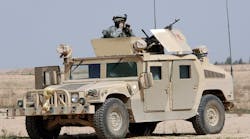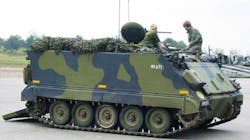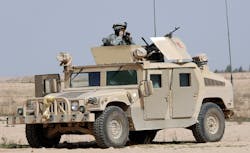Robotics and Autonomous Vehicles Will Impact Future Battlefield Strategies
Robotics and autonomous vehicles could play a major role in the future battlefields after their associated technologies mature. The goal of these technologies is to provide minimal exposure of soldiers to hazardous situations and environments. To reach that goal, the future battlefield will require more unmanned operations, like autonomous fighting vehicles that meet military’s environment, reliability, and survivability requirements.
Recently, the military robotics and autonomous vehicle potential was previewed at the Maneuver Center of Excellence (MCoE) at Fort Benning, Ga. It was part of a demonstration of the Maneuver Robotics and Autonomous Systems (MRAS). This was a result of the McoE’s decision that it had to turn to science and technology to develop future combat vehicles.
The MRAS demonstration was the first event of a three-year process that involves scientists and developers from the U.S. Army Tank Automotive Research, Development and Engineering Center, U.S. Army Armament Research, Development and Engineering Center and the Office of Naval Research. The demonstration showcased progress made in designing and using autonomous combat vehicles and unmanned aerial systems together in scenarios aimed at improving the effectiveness of ground combat formations.
“Robotics and autonomous systems help provide a way to give us enhanced capability to the formation, and provide a greater range of operations,” said Dr. Robert Sadowski, Robotics Senior Research Scientist, U.S. Army Tank Automotive Research, Development and Engineering Center. “We can use robots to do those things they do well and offset those things that humans do well.”
Explaining further, Don Sando, deputy to the commanding general, and director of Capabilities Development and Integration for the Maneuver Center of Excellence at Fort Benning, said, “You can pair unmanned aerial systems and unmanned ground systems and ground forces to extend the reach of that formation, and extend the time over which they can be effective, to reduce the risk to our soldiers in conditions of uncertainty.”
The M113 APC was retrofitted so that a human driver could still operate the vehicle like a normal M113. During unmanned operations, a driver can also act as a safety driver and intervene by pulling the steering/brake levers, if necessary.
One demo featured a robotic (unmanned) Humvee with a remote weapon station and an automated target tracking system performing a live-fire demonstration, along with a tethered unmanned aircraft system to increase situational awareness.
The intent of these demonstrations was to illustrate the possible experimental systems or technology available today, said Maj. Alan Stephens, lead project officer for the MCoE’s Mounted Requirements Division. For instance, surrogates such as the M113 Armored Personnel Carriers (APC) and the Humvee (photos above) were used in this demonstration as low-cost mobility platforms.
Also previewed was a robotic (unmanned) M113 APC that deployed ground robots from its troop compartment. This version of the M113 APC is an Autonomous Unmanned Guided Vehicle (AUGV) that performs tasks with a high degree of autonomy. The AUGV is designed to develop autonomous technologies by employing machine perception, autonomous navigation and supervisory control, vehicle control, and actuation and teleoperation.
Besides various sensors, the M113 had to be retrofitted with actuators to control its steering levers, gear change lever, and accelerator pedal, along with other actuators for safety. Due to its tracked locomotion and large mass, the control algorithm development was challenging and required many trials in the field.
You can control this M113 remotely from a base station by transmitting a live video feed acquired by a camera system on board the AUGV. Vehicle status, such as vehicle location, speed, heading, and pitch and roll are also transmitted to the base station via a digital radio channel. A similar digital RF channel transmits the commands from the base station to the AUGV.
The AUGV can navigate autonomously between waypoints defined by GPS coordinates. To accomplish this, a few capabilities have to be combined:
- Obstacle avoidance where the AUGV’s machine perception modules detect the presence of obstacles and send this information to a path planning module.
- Road segmentation that allows the AUGV to detect unstructured roads.
- Vehicle Navigation Module that combines the local terrain information with the global objective.
Operating an AUGV is much more challenging than an automobile driving on a smooth, paved city street. The difference is in the terrain an AUGV might encounter. The terrain might be open and semi-structured, usually located at the junction of a number of wide dirt roads. Semi-structured refers to dirt roads that are defined by vegetation on both sides. These roads are often covered in dirt and gravel. Or, there could be hilly mountain roads.
The overall system architecture of the AUGV is shown below. Subsystems include:
- Visual Guidance System (VGS)
- Vehicle Piloting System (VPS)
- Vehicle Control System (VCS)
- Teleoperation Control System (TCS)
- Robust Communication System (RCS)
AUGV architecture consists of five subsystems: VGS, VPS, VCS, TCS, and RCS.
RAS Strategy
This Fort Benning demonstration was part of the Army’s Robotics and Autonomous Systems (RAS) strategy that directs actions necessary to achieve unity of effort in the integration of ground and aerial RAS capabilities into Army organizations. Effective integration of RAS improves U.S. forces’ ability to maintain overmatch and renders an enemy unable to respond effectively. According to this RAS strategy, the Army must pursue these capabilities with urgency because adversaries are developing and employing a broad range of advanced RAS technologies as well as employing new tactics to disrupt U.S. military strengths and exploit perceived weaknesses. RAS is increasingly important to ensuring freedom of maneuver and mission accomplishment with the least possible risk to soldiers.
Advancements in RAS vehicles allow persistent surveillance and reconnaissance over wide areas, often going where manned systems cannot, thereby increasing standoff distances, survivability, and reaction time for commanders. This is important because complex terrain and enemy countermeasures limit soldiers’ ability to see and fight.
In addition, autonomous systems lighten equipment loads and increase soldier speed, mobility, stamina, and effectiveness. RAS facilitates mission command by collecting, organizing, and prioritizing data to aid decision-making.
Soldiers are vulnerable at the end of extended supply lines. To help them, air and ground unmanned systems and autonomy-based capabilities enhance logistics at every stage of supply movement to the most forward tactical supply points. RAS moves material to the urgent points of need and provide options for Army logistics distribution to the soldier.
The congested and contested future operational environment increases soldiers’ exposure to hazardous situations. Therefore, RAS technologies can enhance soldiers’ survivability by providing greater standoff distance from enemy formations, rockets, artillery, and mortars. RAS could also place fewer soldiers at risk during convoy operations.
Of the above objectives, the priority in the near-term is to increase situational awareness and lighten the soldier’s physical load, which will improve combat effectiveness. In the mid-term, the priority is to improve sustainment and soldier protection with automated convoy operations. The autonomous technology within automated convoy operations will transfer to many other future initiatives, such as unmanned combat vehicles. In the far-term, the priority is to facilitate maneuver with unmanned combat vehicles, which will increase capabilities within brigade combat teams. Achieving these objectives and integrating RAS into existing formations will take time and calls for an evolutionary approach.
One speaker at Fort Benning admitted that the Army doesn’t quite know exactly what to do with robot and autonomous technology. Theoretically, the Army can automate any vehicle it wants, but it can’t automate them all, nor should it. For control of weapons there should always be a “man in the loop.”
The Army isn't the only one experimenting with robotics—the Marines are conducting similar experiments focused on their mission of storming beaches.




